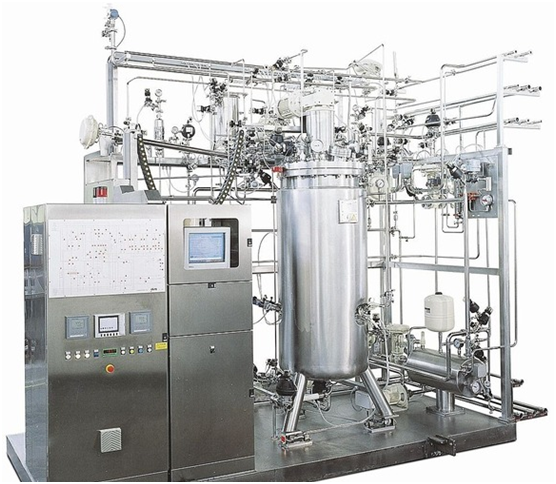Anaerobic digestion is simply defined as the anaerobic breakdown of complex materials of animal or plant origin to simpler substances by microbes. It is the process in which complex organic matter are completely degraded to a mixture of solid and gaseous end products in the absence of oxygen and with the help of a diverse community of microorganisms especially methanogenic bacteria and archaea. The end products of anaerobic digestion are of industrial and economic importance. For example, the gaseous end products including methane gas, carbondioxide, biogas, hydrogen sulphide, hydrogen and ammonia have applications in many other industrial and domestic endeavours.
In the absence of terminal electron acceptors such as oxygen and nitrate, complex organic materials of plants and animals that are difficult to degrade can be broken-down or metabolized by diverse array of microbes including methanogenic organisms that have similar metabolic pathways. The macromolecules of life including polysaccharides (carbohydrates), lipids and proteins can easily be broken down to their respective monomers which are simple sugars (glucose), fatty acids and glycerol and amino acids.
These simpler molecules (monomers) can be metabolized or fermented by various microbes including Clostridium species, Bacteroides species, Selenomonas species, Veillonella species and Succinivibrio species to economically and industrially important end products such as propionate, succinate, acetate, lactate, ethanol, butyrate, hydrogen and carbondioxide. However, some organic materials such as lignin cannot be easily degraded. Lignin degradation is only made possible in anaerobic conditions carried out by anaerobes that mediate anaerobic digestion reactions. Anaerobic digestion is common in anaerobic ecosystems where obligate anaerobic bacteria are commonly found.
Methanogens (i.e. members of the domain Archaea) are obligate anaerobic organisms that occur in a variety of environments including rumen (stomach) of ruminant animals and in mud’s; and these organisms are critical for anaerobic digestion processes either in living systems (as obtainable in the rumen of ruminant animals) or in non-living systems such as in sewage or waste water treatment. Methanogens are critical in carrying out Methanogenesis – the process in which methane (CH4) gas is produced through an energy yielding process that is mediated by certain organisms in the domain Archaea under anaerobic conditions. The methanogens have the ability to metabolize carbondioxide and hydrogen to CH4 under anaerobic conditions.
Anaerobic digestion has application in several processes of life; and it is carried out by a variety of microbes including but not limited to bacteria and organisms in the domain Archaea. Anaerobic digestion is the biotechnological application of Methanogenesis; and anaerobic digestion has application in several areas that are of economic importance especially in the area of environmental pollution control or management. Anaerobic digestion is applied in the treatment of industrial and municipal waste waters. It is also applied in the treatment of sewage, sewage sludge’s and animal manures to produce environmentally-friendly end products such as the methane gas.
Anaerobic digestion is significant in sewage treatment because the process leads to a substantial reduction in the bulk of the biodegradable solids. In sewage treatment and in the treatment of other animal or plant organic materials including agricultural wastes and industrial effluents, anaerobic digestion can yield a rich, relatively odourless agricultural fertilizer (i.e. biofertilizer). This agricultural fertilizer (biofertilizer) is rich in microbial biomass; and such fertilizers help to unlock nitrogen and phosphorus (which are both vital for plant growth) from the soil in order to promote optimal plant growth. And unlike chemical fertilizers which adversely affect the texture of the soil and the environment, biofertilizers are environmentally-friendly and do not adversely affect the soil’s ability to promote agricultural practices.
Anaerobic digestion can also lead to the production of biogas including sludge gas, marsh gas and sewer gas that are clean, environmentally-friendly and of immense importance in both domestic and industrial processes. The potential production of significant amounts of renewable energy amongst other varieties of economically and industrially important end products makes anaerobic digestion an invaluable tool or technology in transforming agricultural, domestic and industrial wastes into environmentally-friendly products.
Anaerobic digestion helps in the preservation of fossil fuels by providing alternative sources of energy using microbes that degrade organic pollutants under anaerobic conditions. The application of anaerobic digestion for treatment and management of industrial and municipal wastes as aforementioned also help in environmentally sustainability since anaerobic digestion reduces the release of polluting emissions into the atmosphere by converting plant and animal organic wastes to re-usable forms of energy that has little or no untoward effect to the environment. There are four biological conversion processes that occur in anaerobic digestion; and these processes are hydrolysis, acidogenesis/fermentation, acetogenesis and Methanogenesis.
Hydrolysis is usually the first stage in anaerobic digestion of organic plant and animal wastes; and it is carried out by hydrolytic fermentative bacteria including facultative and obligate anaerobes. Hydrolysis facilitates the enzymatic breakdown of complex organic plant and animal matter into simpler substances. Cellulase, amylase, protease and lipase are examples of enzymes that catalyze the enzymatic hydrolysis of organic materials during hydrolysis. Cellulases hydrolyze cellulose to glucose; amylases hydrolyze starch to glucose; proteases hydrolyze proteins to amino acids; lipases hydrolyze lipids (fats and oil) to fatty acids and glycerol.
These enzymes are vital for the hydrolytic digestion of organic wastes including agricultural wastes into their respective monomeric units required for further fermentative reactions. During fermentation, the long chain and short chain fatty acids, sugars and amino acids are metabolized by hydrolytic and non-hydrolytic fermentative bacteria to produce a wide variety of fermentation end products including carbondioxide, hydrogen, ethanol, propionic acid, alcohols, ketones, aldehydes, acetic acid and butyric acid.
Acetogenesis is mainlycharacterized by the formation of acetate. It is the process of forming acetate by acetogens through a variety of metabolic pathways including homoacetate fermentation, mixed acid fermentation and propionic acid fermentation. Many products of acidogenesis are further oxidized to acetate, hydrogen and carbondioxide during acetogenesis; and these reactions are mainly catalyzed by obligate hydrogen-producing acetogens (also known as obligate hydrogenogens) such as Synthrophomonas species and sulphur-reducing bacteria. Acetogens are bacteria that produce acetate as their sole end product from certain sugar fermentation. Acetobacterium species, Clostridium aceticum and C. thermoaceticum are typical examples of acetogens. Acetogens also include bacteria that can use protons as final electron acceptors for the oxidation of certain substrates including fatty acids, glucose, lactate and ethanol to acetate with simultaneous formation of hydrogen.
Methanogenesis is the final step in the anaerobic digestion of organic plant and animal wastes. It is carried out by methanogens (i.e. strict anaerobic archaea) – which are known to generate methane (CH4) gas by the reduction of carbondioxide (CO2) using hydrogen (H2) as the electron donor. Methanogens can produce methane gas through a variety of metabolic pathways but the reduction of CO2 using H2 as an electron acceptor is commonly observed amongst the methanogens carrying out methanogenesis. Several factors including pH, temperature, nutrient availability and the presence of toxic compounds (that inhibit the growth of the anaerobes that drives anaerobic digestion) are known to influence the success rate of anaerobic digestion of organic materials. The recycling of livestock wastes and other organic plant and animal materials through anaerobic digestion holds the potential for effective management of solid and liquid wastes.
References
Abrahams P.W (2006). Soil, geography and human disease: a critical review of the importance of medical cartography. Progress in Physical Geography, 30:490-512.
Ahring B.K, Angelidaki I and Johansen K (1992). Anaerobic treatment of manure together with industrial waste. Water Sci. Technol, 30, 241–249.
Andersson L and Rydberg L (1988). Trends in nutrient and oxygen conditions within the Kattegat: effects on local nutrient supply. Estuar. Coast. Shelf Sci, 26:559–579.
Ballantyne A.P, Alden C.B, Miller J.B, Tans P.P and White J.W.C (2012). Increase in observed net carbon dioxide uptake by land and oceans during the past 50 years. Nature, 488: 70-72.
Baumgardner D.J (2012). Soil-related bacterial and fungal infections. J Am Board Fam Med, 25:734-744.
Bennett E.M, Carpenter S.R and Caraco N.F (2001). Human impact on erodable phosphorus and eutrophication: a global perspective. BioScience, 51:227–234.
Bunting B.T. and Lundberg J (1995). The humus profile-concept, class and reality. Geoderma, 40:17–36.
Chang S.T (2006). The world mushroom industry: trends and technological development. International J. Medicinal Mushrooms, 8:297-314.
Jee C and Shagufta (2007). Environmental Biotechnology. APH Publishing Corporation, Darya Ganj, New Delhi, India.
Maier R.M, Pepper I.L. and Gerba C.P (2000). Environmental Microbiology. Academic Press, San Diego.
Miguel A, Manuel F, Francisco J.P and Antonio B (2006). Environmental biocatalysis: from remediation with enzymes to novel green processes. TRENDS in Biotechnology, 24(6):1-7.
Mishra B.B, Nanda D.R and Dave S.R (2009). Environmental Microbiology. First edition. APH Publishing Corporation, Ansari Road, Darya Ganj, New Delhi, India.
Paul E.A (2007). Soil Microbiology, ecology and biochemistry. 3rd edition. Oxford: Elsevier Publications, New York.
Pelczar M.J Jr, Chan E.C.S, Krieg N.R (1993). Microbiology: Concepts and Applications. McGraw-Hill, USA.
Discover more from #1 Microbiology Resource Hub
Subscribe to get the latest posts to your email.



